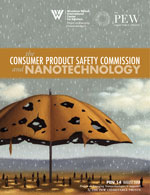Consumer Product Safety Commission Not Ready For Nanotech
Agency lacks budget, authority and expertise to ensure nanoproducts are safe
 Washington, DC — The inability of the Consumer Product Safety Commission (CPSC) to carry out its mandate with respect to simple, low-tech products such as children’s jewelry and toy trains bodes poorly for its ability to oversee the safety of complex, high-tech products made using nanotechnology, according to a new report released by the Project on Emerging Nanotechnologies (PEN).
Washington, DC — The inability of the Consumer Product Safety Commission (CPSC) to carry out its mandate with respect to simple, low-tech products such as children’s jewelry and toy trains bodes poorly for its ability to oversee the safety of complex, high-tech products made using nanotechnology, according to a new report released by the Project on Emerging Nanotechnologies (PEN).
 Two nanotech products under the jurisdiction of the CPSC are being used in the Olympic Games in Beijing – a pair of running shoes and a swimsuit. The products can be found in PEN’s consumer product inventory, which now contains more than 800 manufacturer-identified, nanotechnology-enabled items.
Two nanotech products under the jurisdiction of the CPSC are being used in the Olympic Games in Beijing – a pair of running shoes and a swimsuit. The products can be found in PEN’s consumer product inventory, which now contains more than 800 manufacturer-identified, nanotechnology-enabled items.
“The agency lacks the budget, the statutory authority and the scientific expertise to ensure the hundreds of nanoproducts now on the market, among them baby bottle nipples, infant teething rings, paints, waxes, kitchenware and appliances, are safe. This problem will only worsen as more sophisticated nanotechnology-based products begin to enter the consumer market,” argues E. Marla Felcher, who teaches at Harvard University’s Kennedy School of Government and is the author of the report, The Consumer Product Safety Commission and Nanotechnology.
The CPSC is charged with protecting the public against unreasonable risks of injury or death associated with consumer products. More than 15,000 consumer goods fall under the CPSC’s jurisdiction, including toys and baby products, sports equipment, fitness equipment, home improvement and garden equipment, clothing, appliances, electronics and computers. The consumer product inventory maintained by PEN indicates that nanotechnology has already found its way into every one of these product categories.
“During the fall of 2007, many Americans faced a hazard in their products that had been banned for 30 years — lead. As millions of children’s toys coated with lead paint were recalled, it became clear that government oversight had failed, and that the CPSC, the agency primarily responsible for the oversight of these toys, was stretched too thin from years of neglect, underfunding and the challenges posed by an increasingly global manufacturing system,” says PEN Director David Rejeski. “It is against this background that we need to ask the question: Is the CPSC adequately prepared to deal with nanotechnology, which is now associated with more than 800 manufacturer-identified consumer products ranging from infant pacifiers to paints to appliances to clothing?”
The release of PEN’s new report comes on the heels of the president signing legislation that eliminates lead in toys and either permanently or temporarily bans six types of phthalates in children’s products, which are under the CPSC’s jurisdiction. Phthalates are a broad family of chemicals primarily used to make vinyl soft and flexible and are found in thousands of products including toys, garden hoses, wiring and cables, construction materials, flooring, automotive interiors and medical devices.
Felcher’s report identifies many similarities between the issues raised by phthalates and nanomaterials: many of the same products that contain phthalates are now being made with nanomaterials (e.g., infants’ pacifiers and teething rings); both phthalates and nanomaterials can enter the human body through multiple pathways, such as the lungs or digestive tract; and jurisdiction over phthalates in the United States, like jurisdiction over nanomaterials, is spread over multiple agencies, including the Environmental Protection Agency and the Food & Drug Administration.
But despite these similarities, phthalates and nanomaterials differ in two important respects, Felcher says. First, phthalates have been the subject of thousands of scientific studies documenting their effect on the health of animals and humans—some demonstrating a link between the chemicals and decreased sperm count and sexual malformation in boys—while little is known about possible chronic hazards associated with nanomaterials. Second, nanomaterials are scientifically far more diverse than phthalates, increasing the complexity involved in understanding their toxicology.
“It took decades of research before lawmakers found the political will to keep lead and phthalates out of toys. It could take a very long time to research and ensure that potentially dangerous nanomaterials are kept out, too,” says Rejeski.
The new PEN report includes a number of recommendations Felcher believes will help the CPSC to improve its oversight of nanomaterials in consumer products, including:
Building the CPSC’s nanotechnology knowledge base and expertise.
Identifying companies and industries that are currently manufacturing nanoproducts and request that they submit research studies, risk assessment data and any information they possess that will enable the CPSC scientists to assess nanoproduct safety.
Urging Congress to amend the Consumer Product Safety Act to give the CPSC the authority to require manufacturers to identify any nanomaterials in their products.
Encouraging Congress to adopt a section of the Consumer Product Safety Act bill recommended by the National Commission on Product Safety in its 1970 Final Report, which would give the CPSC the authority to promulgate safety standards for “new” consumer products based on new and emerging technologies, including nanotechnology.
August 21, 2008
Summary
The inability of the Consumer Product Safety Commission to carry out its mandate with respect to simple, low-tech products such as children’s jewelry and toy trains bodes poorly for its ability to oversee the safety of complex, high-tech products made using nanotechnology, according to a new report written by consumer product expert and Harvard lecturer E. Marla Felcher.


